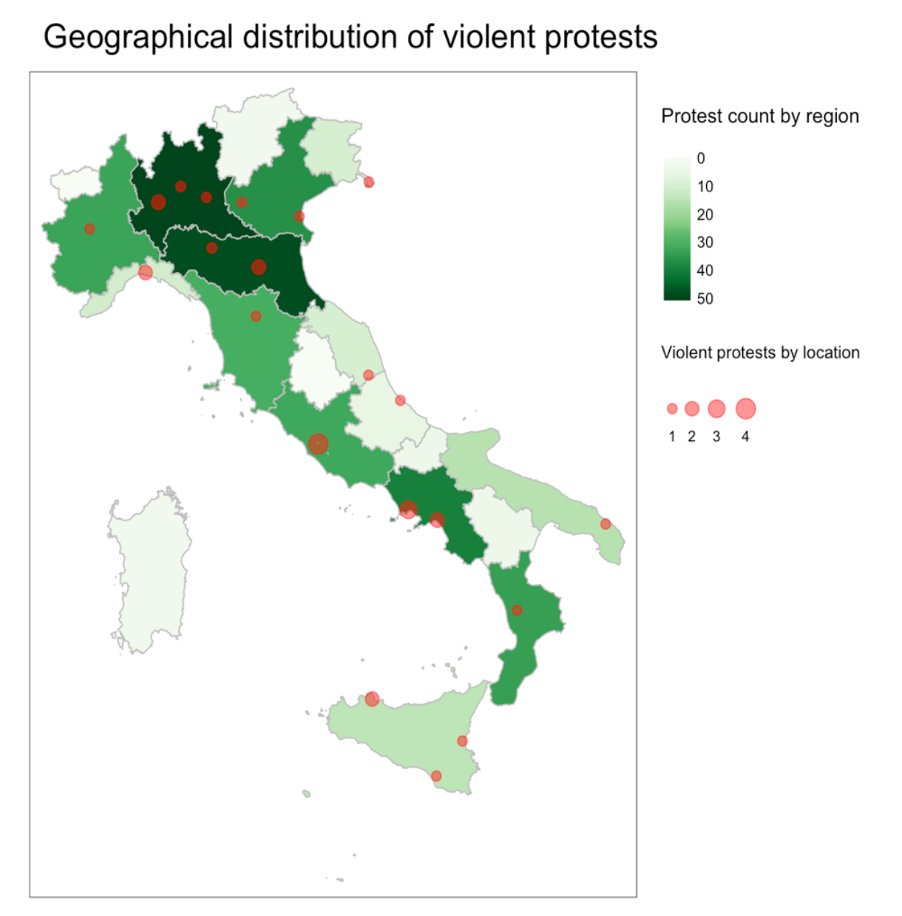Thread on protests in Italy.
Did policies tackling the 2nd wave of COVID-19 trigger protests? Many protests? And was violence common? Where did they happen? Who were the main protesters? What did they protest for? Few points by @gspataf95 @adammccauley Fabio D'Aguanno & me 1/17
Did policies tackling the 2nd wave of COVID-19 trigger protests? Many protests? And was violence common? Where did they happen? Who were the main protesters? What did they protest for? Few points by @gspataf95 @adammccauley Fabio D'Aguanno & me 1/17
We coded -using national & local newspapers - 371 protests over 3 weeks (21/10-14/11). By “protests”, we refer to a repertoire of collective acts intended to voice dissent against polices by Italian authorities to tackle COVID19. (e.g. demonstrations, marches, obstructions). 2/17
Are these many? if anything, underreporting. Minister of interior said 650 public protests. Baseline? Klein & Regan - global protests data – show a yearly mean of 7 protests in Italy between 1990/2018. Della Porta & Tarrow for the “hot” 1966-1973, coded 52 protests per month.3/17
The size of the protests varied from less than 20 protesters (10%) to more than 1500 protesters (4%). However, the mode demonstration was between 100/300 protesters (31%). 79% of Italy’s provinces had some form of protests. All but 2 out of 20 regions recorded protests. 4/17
The participation to protests was significant, drawing up to 30,000 people to the streets on the 28th Oct. and 25,000 on the 26th. After first week, the average number of participants stabilizes at less than 5,000 people per day, with the exception of the 5th & 7th of Nov. 5/17
Where did they happen? The regions with the highest number of protests are Lombardy (50), Emilia Romagna (48),Campania (39), Veneto (36), and Calabria (33). The cities with the highest number of protests were Rome (22), Naples (21), Bologna (20), Milan (19) and Turin (15). 6/17
To understand average protest participation: we computed the ratio of participant size to the population, by region and by province. Top two regions are Friuli-Venezia Giulia & Calabria. The top 3 provinces number of protesters per 1000 residents: Trieste, Parma and Cosenza. 7/17
Were the protests violent? Violence occurred in only 32 cases (8.6% events). Big cities were main locations: Rome (4) & Naples (3), followed by Milan, Bologna, Palermo, Genova & Salerno (2), and other 15 cities with 1 case. Violent events clustered in the initial period. 8/17
Who did protest? The main groups voicing dissent were business owners, present in 68% of protests. The second most common category in the data is “unspecified people”(45%), followed by workers (21%). Trade unions were present in 61 (16%) events and students in 19 events. 9/17
Why did they protest? The stated reasons (from news) to protest were economic hardship (74%), followed by civil liberties (58%). 29 protests made claims about undemocratic practices, whereas in 36 cases protesters contested the existence of COVID-19. 10/17
How did they protest? Most common forms of protest were static assemblies (78%), marches (21%), institutional meetings (14%). These are followed by obstructions of public spaces (36 cases), public statements (32),organised curfew violations (31), riots (7), & strikes (6). 11/17
Were political organizations present? In 1 out of 3 protests non-parliamentary &/or parliamentary political parties/groups attended/organised protests. Right-wing for 42.5 % and radical right groups for 40.2%. Then radical left (29.9%), anarchist groups only in 8 protests. 12/17
In 2020, Italian citizens experienced the most important limitation of civil liberties & movement restriction in the country’s Republican history. Groups protesting were mostly business owners who voiced their protests with peaceful means & within parameters of legality. 13/17
The "political geography of protest" cannot be explained easily and most likely features a diverse set of drivers leading to similar contentious behaviours. Yet, the main claim is not against fighting the virus but against economic effects of restrictions & lockdown. 14/17
Political organizations & parties are not the main organizers. However, some parliamentary parties took advantage of this to echo their anti-government position (Fratelli d’Italia especially). Also radical right & radical left groups grabbed the opportunity to demonstrate. 15/17
Economic transfers to citizens by government could address part of the emergencies several citizens are facing. Yet it shouldn’t be undepreciated how large part of society being based on undeclared work/informal economy - > 3 millions- will not benefit from these supports. 16/17
Caveats: this is work in progress, data quality checks are ongoing. Soon we will update the data, provide a more elaborated methods section and see if political, economic or COVID-19 variables correlate with protests’ incidence. See our full report here https://www.aruggeri.eu/protests-italy

 Read on Twitter
Read on Twitter











